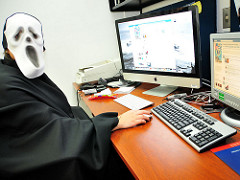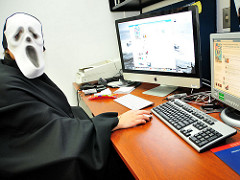
We may not be kids anymore, but many of us still love Halloween. And workplace celebrations offer more than a sugar rush and the chance to wear something silly — they can be a simple yet effective way to boost morale.
As such a widely celebrated holiday, Halloween is unlikely to raise issues of discrimination or offense, so it’s a great opportunity for a party. Still, Halloween celebrations can be steeped in haunting possibilities.
Here are some of our Frequently Asked Questions about handling Halloween in the office:
What are the biggest potential problems a workplace can face when it comes to Halloween parties?
Sexual harassment, a hostile work environment, alcohol-related issues and physical safety, according to an article by the balance. Sometimes, people in costumes act in ways they might not otherwise, or their costumes create problems. Employees who have been drinking are more prone to inappropriate behavior and safety accidents. Even at parties, employers are responsible for safety. Injuries during celebrations should be included in OSHA reporting.
These potential risks may sound scary, but there are common-sense ways to sidestep the horror and still enjoy a workplace Halloween celebration.
What details should we consider when planning a Halloween celebration?
Any office celebration should attempt to account for different employees’ needs, offering a variety of food, beverage and activity options. Consider your audience — if you invite families and children, you may have to adjust your plans so everyone feels comfortable. Make clear that employees are not required to participate if they don’t want to.
Use common sense and think through safety factors for anyone attending the celebration. Pumpkin carving, for example, can be problematic if young children will be attending or if alcohol will be served.
Should I set out rules in advance for Halloween or handle situations as they arise?
It’s always good to be proactive. Communicate details of the celebration well in advance, and address topics such as acceptable costumes, expectations about work duties, and alcohol use, if that will be a part of the celebration.
Invitations can include reminders that costumes should be G-rated and sensitive to differing opinions, and that employees still must act professionally. Many concerns may become moot if a celebration focuses on employees’ children — that helps keep adults’ behavior in check. However, in those cases, it may be helpful to lay some ground rules for expectations regarding children in the office.
Even with advance communication, unexpected situations can arise. Think through how you might handle possible problems, and be prepared to address any issues discreetly, quickly and effectively.
What is the best way to handle any dress code violations, such as costumes that are too cumbersome, distracting or risqué?
Half of respondents to an informal survey by Glassdoor said that human resources should ask people wearing inappropriate costumes to change. Fourteen percent said such people should be sent home.
Ultimately, however, it’s best to set clear expectations ahead of time to avoid uncomfortable situations altogether. Keep in mind that inappropriate costumes aren’t just those that are too revealing — bulky costumes could cause difficulties getting work done or pose a tripping hazard. Political costumes could cause certain employees to feel alienated or threatened. Encourage common sense and courtesy when making costume selections; those with questions could always ask an HR rep ahead of time.
Need advice specific for your situation? Contact People People today, and keep the tricks out of your office Halloween celebration.

